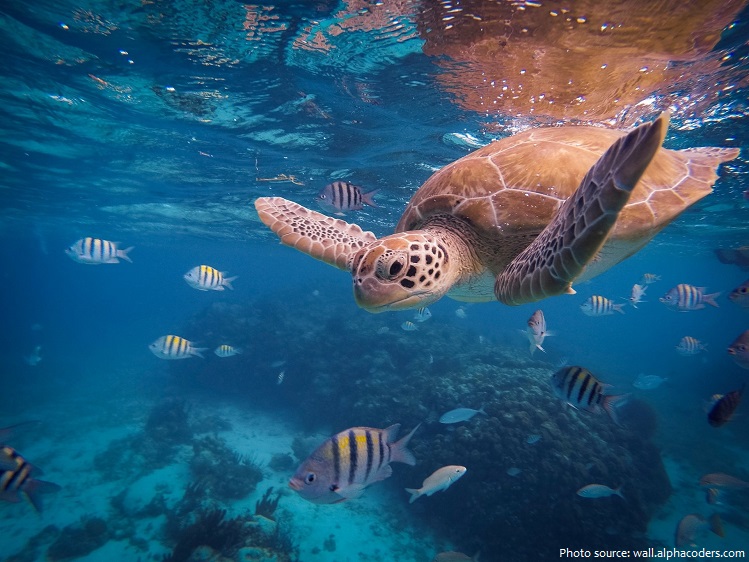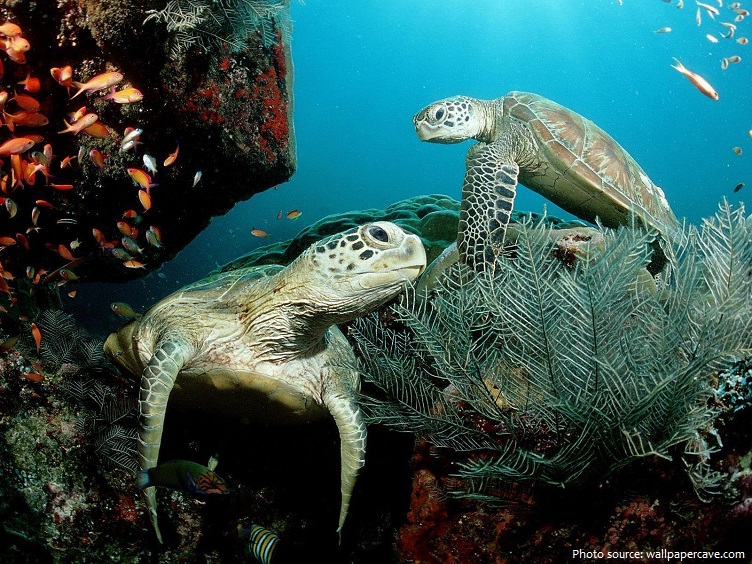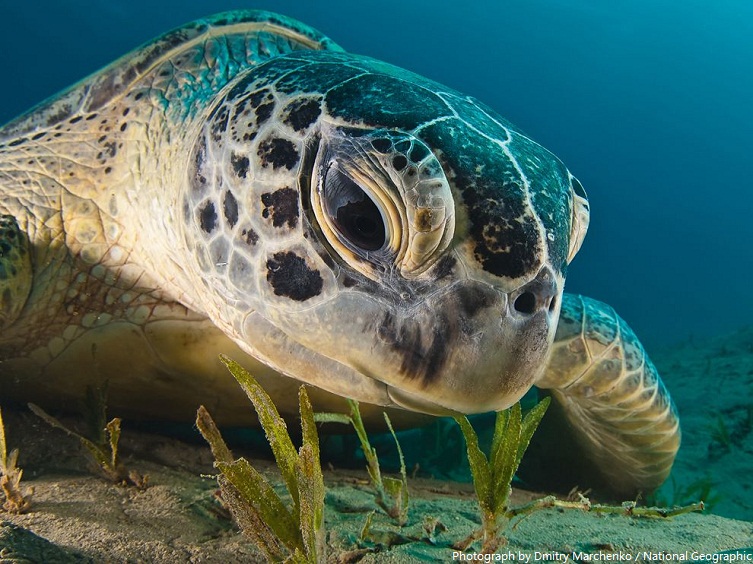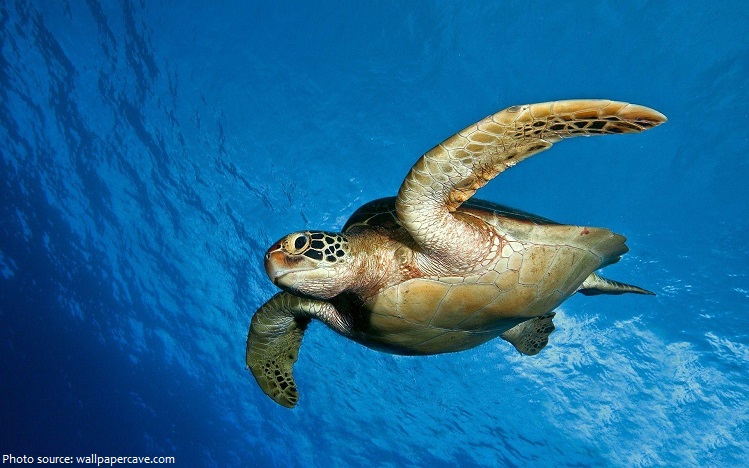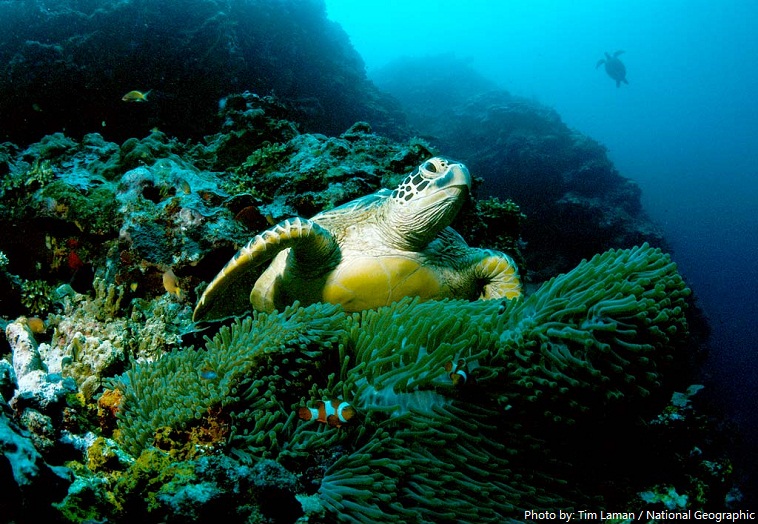The green sea turtle (Chelonia mydas) is one of the largest sea turtles.
It is a cosmopolitan species found in tropical and subtropical waters.
Green sea turtles are common in shallow waters as well as coastline beaches.
The lifespan of a green sea turtle is up to 80 years in the wild.
The green turtle is the second largest after the leatherback.
Adult green turtles grow to 1.5 meters (5 feet) long; the average carapace length is from 78 to 112 cm (31 to 44 in).
The average weight of mature individuals is from 68 to 190 kg (150 to 419 lb). Exceptional specimens can weigh 315 kg (694 lb) or even more, with the largest known specimen having weighed 395 kg.
They have upper shells in several colors including gray, black, olive, and brown and a much lighter underside is whitish to yellow.
The species’ common name does not derive from any particular green external coloration of the turtle. Its name comes from the greenish color of the turtles’ fat, which is only found in a layer between their inner organs and their shell.
This sea turtle unlike other sea turtles, is predominantly herbivorous and feeds on algae or marine grasses; However, juveniles are carnivorous and feeds on fish eggs, molluscs, jellyfish, small invertebrates and worms.
Green sea turtles typically swim at 2.5 to 3 km/h (1.6 to 1.9 mph); but if threatened they can reach speeds of up to 35 km/h (22 mph).
Green sea turtles cannot breathe underwater, but they can hold their breath for long periods of time — about 5 hours when resting. While holding their breath, their heart rate slows significantly to conserve oxygen — up to nine minutes can pass between heartbeats.
Green sea turtles tend to have good vision, well adapted to a life at sea. On land, however, the sea turtles are nearsighted because the lenses in the eyes are spherical and adjusted to refraction underwater.
Like other sea turtles, green turtles make long-distance migrations from their feeding areas to nesting beaches in the tropics and sub-tropics; ; some swim more than 2,600 kilometers (1,600 miles) to reach their spawning grounds.
Since green sea turtles migrate long distances during breeding seasons, they have special adaptive systems in order to navigate. In the open ocean, the turtles navigate using wave directions, sun light, and temperatures.
The sea turtles also contain an internal magnetic compass. They can detect magnetic information by using magnetic forces acting on the magnetic crystals in their brains. Through these crystals, they can sense the intensity Earth‘s magnetic field and are able to make their way back to their nesting grounds or preferred feeding grounds.
The males arrive in offshore waters first and wait for the females to come to the beaches. Adult males can breed every year, but females only breed every three to four years.
Female green sea turtles lay about 100 eggs per nest and will nest every two weeks over several months before leaving the nesting area and returning to their foraging grounds.
After about 2 months, the eggs hatch and the hatchlings make their way to the water. The newly hatched green sea turtles are very susceptible to predators, exposure, and losing their way. For green sea turtle hatchlings that reach the water, it takes at least 20 to 50 years to reach sexual maturity.
Adult sea turtles have a few predators, mostly large sharks.
Classified as endangered by the IUCN and CITES green sea turtles are threatened by overharvesting of their eggs, hunting of adults, being caught in fishing gear and loss of nesting beach sites.
The green sea turtle is estimated to inhabit coastal areas of more than 140 countries, with nesting sites in over 80 countries worldwide throughout the year.
In the United States Atlantic coast, green sea turtles can be found from Texas and north to Massachusetts. In the United States Pacific coast, they have been found from southern California north to the southernmost tip of Alaska. The largest populations of green sea turtles within the United States coastline are in Hawaii and Florida. Globally, the largest populations of sea turtles are in the Great Barrier Reef in Australia and the Caribbean islands.
In the Hawaiian language it is called honu, and it is locally known as a symbol of good luck and longevity.
